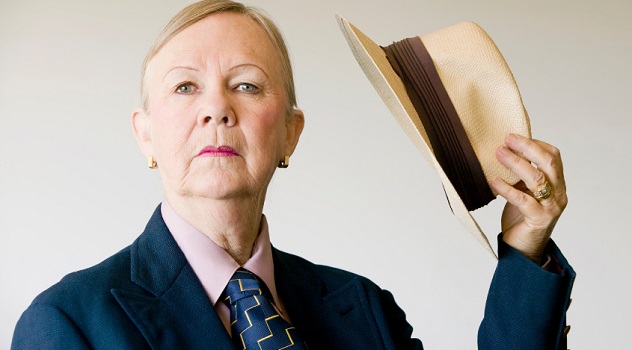 Movies and TV
Movies and TV  Movies and TV
Movies and TV  History
History 10 Things You Didn’t Know About the American National Anthem
 Technology
Technology Top 10 Everyday Tech Buzzwords That Hide a Darker Past
 Humans
Humans 10 Everyday Human Behaviors That Are Actually Survival Instincts
 Animals
Animals 10 Animals That Humiliated and Harmed Historical Leaders
 History
History 10 Most Influential Protests in Modern History
 Creepy
Creepy 10 More Representations of Death from Myth, Legend, and Folktale
 Technology
Technology 10 Scientific Breakthroughs of 2025 That’ll Change Everything
 Our World
Our World 10 Ways Icelandic Culture Makes Other Countries Look Boring
 Misconceptions
Misconceptions 10 Common Misconceptions About the Victorian Era
 Movies and TV
Movies and TV The 10 Coolest Stars to Set Sail on The Love Boat
 History
History 10 Things You Didn’t Know About the American National Anthem
 Technology
Technology Top 10 Everyday Tech Buzzwords That Hide a Darker Past
Who's Behind Listverse?

Jamie Frater
Head Editor
Jamie founded Listverse due to an insatiable desire to share fascinating, obscure, and bizarre facts. He has been a guest speaker on numerous national radio and television stations and is a five time published author.
More About Us Humans
Humans 10 Everyday Human Behaviors That Are Actually Survival Instincts
 Animals
Animals 10 Animals That Humiliated and Harmed Historical Leaders
 History
History 10 Most Influential Protests in Modern History
 Creepy
Creepy 10 More Representations of Death from Myth, Legend, and Folktale
 Technology
Technology 10 Scientific Breakthroughs of 2025 That’ll Change Everything
 Our World
Our World 10 Ways Icelandic Culture Makes Other Countries Look Boring
 Misconceptions
Misconceptions 10 Common Misconceptions About the Victorian Era
10 Female Husbands Of The 1800s
Think gay marriage is a new concept? Newspapers from the 1800s reveal this couldn’t be further from the truth. Although our 19th-century ancestors seemed to act more surprised when reading such stories, there was always a chance that Harry and Sally might’ve really been Harriet and Sally.
After all, in recent American and European history, women sometimes disguised themselves as men. Life was much easier for males. They had more freedom and got better jobs. Getting a wife was a way to further disguise a woman’s true identity. Who would think their effeminate coworker was anything but a man if he/she was married?
10 Death Of A Brick Setter

In 1859, a newspaper reported on an inquest held in Salford, England, regarding the body of a man found in a sluice on the River Irwell. The corpse was identified as Henry Stokes, but upon further investigation (conducted by two women), it turned out that Henry Stokes was actually a woman named Harriet Stokes.
Harriet had run a beer shop in Manchester when she was younger, and afterward, she worked as a brick setter for over two decades. Living as a man for roughly 40 years, she is believed to have married twice in her life. One of her marriages was to another woman.
The jury at the inquest gave the verdict as “found drowned.” No further information was given as to how or why she drowned or if foul play was suspected, but the discovery of Henry Stokes’s biological gender caused quite a stir at the time.
9 From Wife To Husband

In 1883, newspapers across the United States rocked the nation with a story of a woman pretending to be a man. While this sort of thing didn’t usually cause such a big stir, this particular tale had a bit of a twist.
Frank Dubois dressed like a man and was even married to a woman. But one day, a fellow named Hudson recognized Dubois as his wife. In fact, Dubois was the mother of his two children. Naturally, Dubois and her wife quickly packed up and left town, only to be hounded by journalists. After moving a second time to escape prying reporters, Dubois finally admitted to the public that she was indeed a woman. Her wife confirmed the suspicion of her gender but claimed she hadn’t known until their wedding night. But it appears that in spite of the deception, the wife was determined to remain with her female husband.
Once again, newspaper reporters went into a tizzy and wrote outrageous statements such as:
The idea of a woman playing husband, and trying to split wood, or drive team, is absurd. The best woman in the world could not take the place of a man, and do chores around the house, and go down town nights, and come home full of election whisky, without giving herself away.
On the subject of whether a female husband could handle a house burglar, the article went on to say:
Imagine a burglar entering a bedroom occupied by such a couple, in the dead hour of night, to burgle. The spectacle of two heads going under the bedclothes at once, and two female screams, where there was one pair of pants on the floor, would mix up the most hardened burglar, and make him think he had struck a lunatic asylum.
8 The Effeminate Stranger

If an effeminate stranger comes to town, you should probably get to know him a little better—or at least examine the goods—before getting hitched.
Back in 1878, a stranger showed up in the town of Tiffin, Colorado. All anyone knew about him was that he came from Colorado. One of the local teenagers fell in love with the stranger, and against the wishes of the uncle she was living with, the 16-year-old married the newcomer.
By nightfall, she discovered that her new husband was really a woman on the run. The woman needed to give undeniable evidence that she was a he, and what better proof than marrying a female? She threatened the girl, saying if she told anyone, she would kill her.
The two soon moved into a neighboring district, but the woman continued threatening and beating the girl. Finally, the woman decided to flee the country, and the teenager was set free. The girl returned to her uncle’s home, and she told him the story about her strange husband. He went on to report the incident to the local newspaper. No names were given in any of the reports, and there was no follow-up on what or who the woman was running from.
7 From Maidservant To Butcher

In 1822, the Glasgow Chronicle printed a doozy of a story that sent the entire world into a gossip frenzy. Helen Oliver was a maidservant who’d become friends with a young man. However, it turned out that the man was actually a woman in disguise. This gender-bending friend inspired Helen to also pose as a man. Helen became John, and she worked as a plasterer and a butcher for four years. No doubt, the pay was much better than working as a maidservant.
Eventually, for reasons that aren’t completely known, Helen started to court another woman. Some believe she was doing this to remove suspicions that she was really a woman. Another train of thought says she was just playing a cruel joke. Either way, Helen proposed to her girlfriend, but the marriage never happened because a former acquaintance realized John’s true identity. Helen fled the scene and drifted off into obscurity.
6 The Ladies

Women had many personal reasons for becoming men, and not every wife who took a female husband was blind to her spouse’s true gender.
In 1876, the American Citizen published an excerpt of a letter sent from a man in Scotland to his friend in Virginia. The letter told a tale of two ladies who were unhappy in their respective marriages. They confided to each other about their marital misery . . . and then decided to do something about it.
Drawing lots, they decided who would become the man in their new relationship. The one who drew the short straw changed her name to “James Han,” and together, they moved to Epping, Essex. Once there, they leased a home and started an inn. They hired a servant and lived as a married couple, and evidently, they were quite comfortable with their new roles. They were together for 31 years before the wife passed away. As for the husband, James Han held many positions within Epping and nearly became churchwarden before being discovered.
5 The Female Hunter

On February 21, 1882, the Omaha Daily Bee briefly mentioned a female husband who was living as a hunter in Long Eddy, New York. Born as Lucy Ann Lobdell in 1829, she took up hunting as a young woman to help provide for her family. At some point, she married a man named George Washington Slater, but he was abusive and eventually abandoned Lucy Ann and their infant child.
After her husband left, Lucy Ann decided to live as a man and continue hunting. She named herself Joseph Israel and married Marie Wilson in 1877. The two of them lived in caves throughout Monroe County, Pennsylvania, and they survived on berries, roots, and whatever else people gave them to eat.
Lucy Ann was reported as dead in 1879 and again in 1882, but research shows that she didn’t actually pass away until 1912. She died in Binghamton, New York, and as for her wife, she was mentioned in the newspaper clipping from 1882. According to the story, she was 45 years old and in terrible health.
4 False Pretenses

In 1856, a report came out of Syracuse, New York, that a woman had been arrested for marrying under false pretenses. She was living as man and had married a young woman. A few days later, the father-in-law somehow discovered the gender of his “son-in-law,” and he promptly complained to the authorities.
As for the young wife, she felt that the gender of her husband did not matter when it came to their marriage. The newspapers reported that, “The young bride didn’t seem to think that it made any difference and clung to her female husband with all a wife’s affection.” Nevertheless, the female husband was arrested and sent to prison, to which one newspaper remarked, “Under what law she can be punished we confess ourselves ignorant.”
The woman was eventually brought before a judge and released. Neither her name nor the bride’s were released, but one does hope they were able to live out their days in peace.
3 Happy As Clams

In the late 1870s, a female husband named Samuel M. Pollard married a woman named Marancy Hughes in 1878. The two lived together for six months before Marancy went back to her parents’ home. As soon as she returned, Marancy outed her husband as a woman, claiming that Pollard had married her as a cruel joke. Plus, she said the marriage was supposed to help Pollard’s transformation as a man.
The two must have had an explosive relationship. The wife also claimed that Pollard threatened to hurt her if she ever revealed her true gender. On the other hand, Pollard claimed that Marancy left for completely different reasons.
Since the mining town of Tuscarora, Nevada, was short on women, the men were happy to learn that Marancy was once again available. But their happiness was short-lived because Marancy and Pollard soon resolved their differences. A final report declared that, “Mrs. Pollard had returned to the arms of her female husband, and they are again living together as happy as clams at high water.”
2 Countess Sarolta Vay

Not all female husbands took wives in order to get higher-paying jobs. Take Countess Sarolta Vay, for example. She was the daughter of a colonel, and because this guy had so many daughters, he began raising Sarolta as a son.
Eventually, the colonel’s wife gave birth to a boy, but Sarolta decided to remain a male. She didn’t enjoy being treated like a girl. Later on, she left her family and became known as Count Sandor Vay. She married a schoolteacher who was the daughter of a civil servant. But then Vay made a mistake. The count began borrowing money from the father-in-law, and tensions began to rise.
Finally, the wife confessed to her father that Vay was actually a woman. Upon further investigation into the case, it was revealed that the clergyman who’d married the couple probably wasn’t an actual priest. Therefore, the marriage was seen as a fraud and non-binding.
1 Arrested For Vagrancy

When 1899 rolled over in 1900, it was the beginning of an exciting, new century. But while the 1800s might have ended, the trend of outing female husbands certainly did not.
In 1906, The Spokane Press ran an article on a female husband who went by the name of John A. Whittman. As the story goes, Whittman was born as Pauline Webster, and he eventually married a waitress named Etta Jelley. The two had plans to put their money together and start their own restaurant. However, a man named Cornett was holding onto Etta’s money, and when she asked for it, he refused. Even worse, he began looking into her new husband’s background.
Three days after Etta and John were married, Cornett had Whittman arrested on a false vagrancy charge. It was then discovered that John was actually a woman. John had decided to live as a male after discovering she could earn more money doing “man’s work.” When Etta learned that John was actually a woman, she broke into tears. Still, it was reported that, “Etta loved ‘John’ and after ‘his’ arrest, held ‘his’ hand, brought ‘him’ delicacies, and otherwise conducted herself as any bride of three days might have done under the circumstances.”
Elizabeth spends most of her time surrounded by dusty, smelly, old books in a room she refers to as her personal nirvana. She’s been writing about strange “stuff” since 1997 and enjoys traveling to historical sights.





